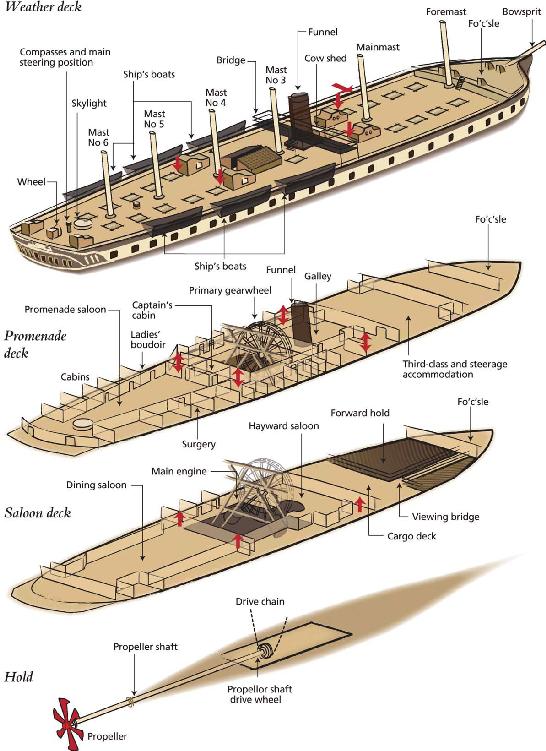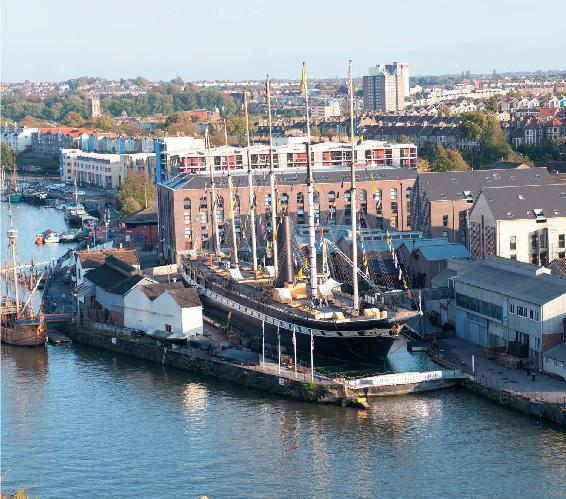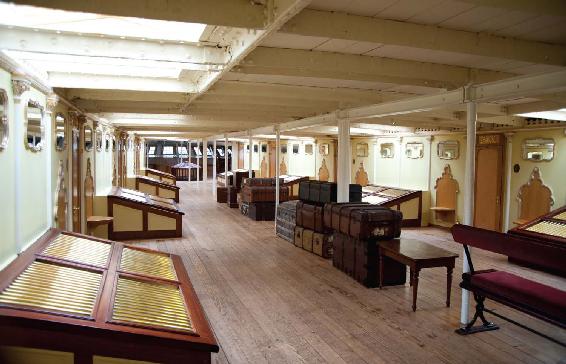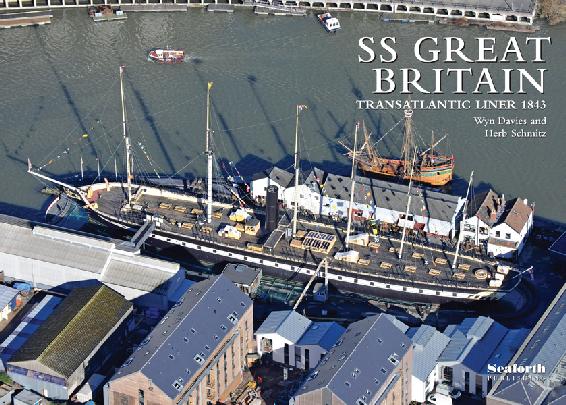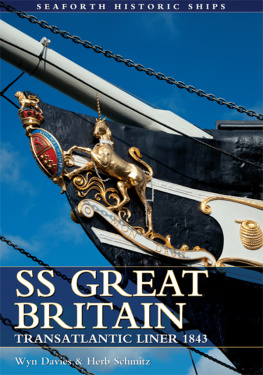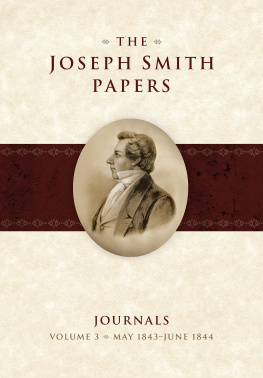The promenade saloon, now perfectly restored, where first-class passengers once exercised and socialised, away from the wind and spray of the weather deck.
The huge iron hull dwarfs the replica of the little Mayflower , the seventeenth-century carrack that carried pilgrims to the new world more than 200 years before Great Britain was built. (Courtesy Great Britain Trust)
Copyright Wyn Davies & Herb Schmitz 2012
First published in Great Britain in 2012 by
Seaforth Publishing,
Pen & Sword Books Ltd,
47 Church Street,
Barnsley S70 2AS
www.seaforthpublishing.com
British Library Cataloguing in Publication Data
A catalogue record for this book is available from the British Library
ISBN 978 1 84832 144 1
eISBN 9781848322868
All rights reserved. No part of this publication may be reproduced or transmitted in any form or by any means, electronic or mechanical, including photocopying, recording, or any information storage and retrieval system, without prior permission in writing of both the copyright owner and the above publisher.
The right of Wyn Davies and Herb Schmitz to be identified as the authors of this work has been asserted by them in accordance with the Copyright, Designs and Patents Act 1988.
CONTENTS
THE SS GREAT BRITAIN IS AN EXTRAORDINARY
survivor from an age of invention and aspiration. She symbol-ises the inventiveness of Brunel and his collaborators who dared to develop new ideas in engineering and transform the future for world travel. She represents the aspiration of thousands of passengers who travelled the world, taking advantage of a revolution in global communication.
The ss Great Britain s story is one of transformation, as well as survival. Her innovative design, combining the technologies of iron construction and a steam-powered propeller, made her the prototype of virtually all modern ships. In 1843, when she was launched, public opinion was divided between scepticism and optimism; some doubted that an iron ship of this size would even float, let along make it across the Atlantic. In the event, her success forced the pace of change, so that within forty years she was although still sound and serviceable overtaken by a new generation of iron- and later steel-built passenger steamers.
The ss Great Britain was built to take advantage of a commercial opportunity, not as a test piece. Her first voyages, carrying passengers between Liverpool and New York, were fraught with technical problems affecting the propeller machinery. Commercial operation meant that these, and other design issues, had to be resolved quickly. Brunels basic concept was soon modified, with development of the engines, the rig and the propeller, to create a vessel which really could go the distance. By the end of her working life, the ss Great Britain had sailed thirty-two times around the world, visited five continents, and travelled nearly a million miles at sea.
Today the ss Great Britain Trust seeks to sustain the inspiration this ship represents. Since 1970, when a heroic salvage brought her home to the drydock in which she was built, millions of people have visited her. The Trust invests not just in conserving the ship, but in offering all of these visitors an authentic and exciting experience of the history she represents. Conserved in her building dock, and surrounded by a glass sea, the ss Great Britain appears ready to set off on her journey once again, carrying todays visitors with her on a new adventure.
As a souvenir of such a visit, this book offers an informed and accessible account of the ships history, generously illustrated with views of the reconstructed interiors and historic source material. The Trust welcomes this addition to the growing range of works on the ss Great Britain and her creator, Isambard Kingdom Brunel.
Dr Kate Rambridge,
ss Great Britain Trust
April 2012
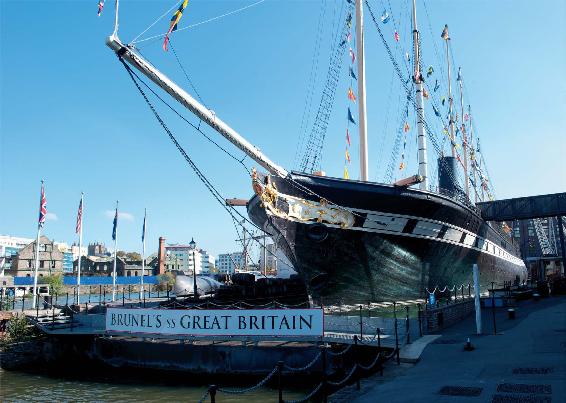
Great Britain faces out of what was originally the Great Western Dock, towards the Bristol docks. This is what she would have looked like, dressed overall in signal flags, on her launch in 1843 when she was floated out.
INTRODUCTION
SOMEONE VISITING BRISTOL DOCKS IN 2012 for the first time in, say, ten years would find it hard to recognise the surroundings, such is the pace of change today; how much harder then would it be for the ghost of a certain Isambard Kingdom Brunel, returning after nearly 200 years to the city he did so much to promote. He might recognise some of Temple Meads railway station, and he would certainly still be able to see his suspension bridge, but were he to catch a glimpse of masts through the many new blocks of offices and flats, he would surely be a little mystified to find his other famous Bristol creation, the SS Great Britain , back in its original berth. Unique amongst heritage vessels preserved in Britain, the Great Britain has been restored and opened to an admiring public on the very spot where she was built.
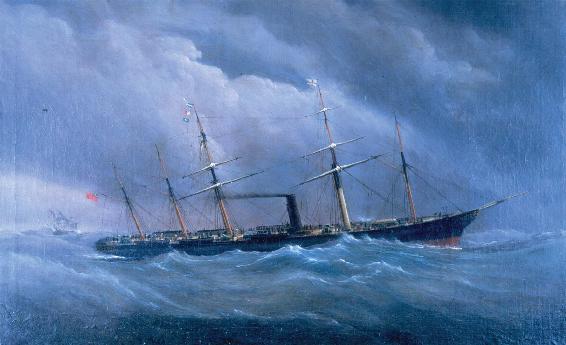
Great Britain s career began in 1843 and lasted until her abandonment in Sparrow Cove in the Falkland Islands in 1937, her internal decking having been removed to build a jetty at Port Stanley. In ninety years she underwent many modifications, and she is depicted here in 1846, her original six-masted schooner rig having been reduced to five masts to improve her balance. (The SS Great Britain Trust)
The largest ship in the world at her launch, built of a material many believed untried, and powered by the still relatively novel steam engine, it was typical of Brunels approach to things that she incorporated several firsts into her design.
Modern engineers are often encouraged to minimise or even eradicate untried features if they wish their project to succeed. Brunel would have none of this timidity. Perhaps fortunately, he was nearly always right and just as often had the force of character to get his proposals accepted. Equally, he was occasionally just that bit too far ahead of his time, and self-induced stress may have contributed to his early death during the building of his next ship, the Great Eastern .
In this book we will attempt to show that Brunels approach to the design of the Great Britain , whilst forward-looking, was still within the realms of what was possible with Britains growing industrial capabilities, and that his thinking was definitely more clear-sighted than many of his contemporaries, although he still needed his powers of persuasion from time to time. The result was a vessel which was a world beater at her launch.
BACKGROUND
